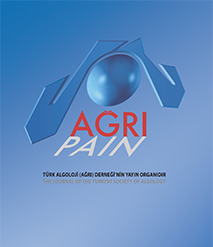Quick Search
Volume: 12 Issue: 3 - 2000
| YAYIN KURALLARI / GUIDELINES FOR PUBLICATION | |
| 1. | Guidelines for Publication Page 6 Abstract |
| YAYIN KURULU / EDITORIAL BOARD | |
| 2. | Editorial Board Page 7 Abstract |
| EDITÖRDEN / EDITORIAL | |
| 3. | Editorial Page 8 Abstract |
| 4. | Prevention and treatment of postoperative pain E. Alon, P. Knessl Pages 9 - 14 Surgical intervention is traumatic, direct lesions to neural structures or an excitation of nociceptors can lead to the perception of pain. Pain causes stress not only in psychological, but also in pathophysiological sense. The understanding of the different origins of acute postoperative pain serves as a base for the design of the therapeutic approach. On the very beginning of the therapeutic considerations, a sufficient amount of basic information about the planned intervention must be provided. This data is needed not only for the planning of the anesthetic procedure, but serves as a source of information about the patient. The analgesic therapy is based upon three types of substances; opioids, nonsteroidal anti-inflammatory drugs (NSAIDs), and local anesthetics. Opioids have been the backbone of the peri- and postoperative analgesia. Their analgesic effect is acompanied by annoying side effects as pruritus, nausea, vomitus, constipation, urinary retention, sedation and respiratory depression. NSAIDs are acting mainly peripherally, and therefore suitable for combination with centrally acting opioids. Local anesthetics are frequently used for postoperative analgesia, mostly via the epidural route. Analgesia can be administered by different routes. The major goals of prevention and treatment of postoperative pain are to minimize or eliminate discomfort, to facilitate the recovery process, to avoid or effectively manage side effects associated with the therapy, and to make the therapy cost effective. |
| 5. | Effect of the tracheal tube cuff content on the postoperative sore throat T. Özkan, G. K. Talu, M. Şentürk, A. Yavru, M Tuğrul Pages 15 - 18 Sore throat is a common and discomforting symptom after endotracheal intubation. The frequency, extent and intensity of sore throat show large variability. We have evaluated the efficacy of different contents of endotracheal tube (ETT) cuffs during anestesia on postoperative sore throat. 185 patients of ASA class I - III undergoing major abdominal surgery assigned randomly into five groups. After tracheal intubation ETT cuffs filled as follows: 4 % lidocaine (L) (Group I, n = 38), 4 % L + 0.1 ml/10 ml 10 % NaHCO3 (Group II, n = 36), saline (Group III, n = 37), ETT cuffs prefilled for 15-20 h with 4 % L and inflated with air after intubation (Group IV, n = 36), air (Group V, n = 38). Number of patients with effort at emergence period was significantly less in Group I and II than the other groups (12, 4, 32, 26, 32 respectively, p<0.05). Number of patients with sore throat and also the severity maesured by 100 mm visuel analog scale were significantly high in Group III and V according to Group II at 1. and 24. hour postoperatively. We conclude that the L filled ETT cuff provides a continuous source of L, may lead to a effortless emergence from anesthesia. It prevents postoperative sore throat and limits the severity of it. |
| 6. | The effects of L-arginine and N-nitro-L-arginine on tail-flick response and morphine analgesia in the mice H. Özbek, Y. Karataş, F. Aksu, D. Özcengiz, S. Y. İnan, G. Işık Pages 19 - 25 The effects of L-arginine, a nitric oxide (NO) precursor and N-nitro-L-arginine (L-NA), a nitric oxide synthase (NOS) inhibitor, on morphine-induced analgesia were determined in the mice using tail-flick test. L-arginine (300 and 500 mg/kg, i.p.) and L-NA (4-16 mg/kg, i.p.) did not elicit any analgesic activity. L-NA, but not L-arginine enhanced antinociception induced by morphine (2.5 and 5 mg/kg, s.c). Naloxone, an opioid antagonist, reversed this effect of L-NA. These results suggest that decreased NO synthesis by NOS inhibitors potentiates peripherally administered morphine analgesia. |
| 7. | Prilocaine and prilocaine - meperidine combination in regional intravenous anesthesia S. Tuncer, H. Barışkaner, L. Pirbudak, Ş. Otelcioğlu Pages 26 - 29 In this study we aimed to assess the effects and side effects of prilocaine and meperidine added to decreased dose and concentration of prilocaine, in sensorial and motor block during regional anesthesia. Thirty ASA I-II patients, undergoing upper extremity operation were studied and randomly divided into two groups. First group recieved 1 % prilocaine while the second recieved 0.5 % prilocaine + 1 mg/kg meperidine in 40 ml of distilled water in 90 seconds in accordance with the RIVA technique. Statistical analysis was done with Mann Whitney-U test and p<0.05 was accepted statistically significant. In conclusion we observed that analgesia and motor block beginning times were shorter and postoperative pain was less in the second group. Thus we think that the combination of meperidine with low dose and concentration of prilocaine is more suitable for regional intravenous anesthesia. |
| 8. | Epidural kateterden verilen ropivakain ve ropivakain + klonidin kombinasyonunun hemodinami ve postoperatif parametreler üzerine etkisi D. Memiş, A. Turan, Z. Pamukçu Pages 30 - 34 This study was applied on 30 cases to assess the effect of ropivacaine and ropivacaine + clonidine combinations on postoperative analgesia and vital signs. Patients in Group I (n=15) received % 0.5 ropivakain and patients in Group II (n=15) % 0.5 ropivacaine + 1 µgr/kg clonidine. Mean arterial pressure, heart rate, SpO2, respiratory rate, pain scores, analgesia time and side effects were recorded for 24 hours. Statistically there was no difference in mean arterial pressure, heart rate, SpO2, and respiratory rates between Group I and II (p>0.05). There was no statiscally important difference between the VAS scores of Group I and II in postoperative 1/2. hour but the VAS scores in 2. and 4. hours were statistically lower in Group II. There was no statistically important difference between the VAS scores of Group I and II in 6., 12. and 24. hours (p>0.05). The differences between postoperative analgesia times and total morphine consumptions in 24 hours were found to be statistically insignificant (p>0.05). As a result epidural administration of ropivacaine + clonidine combination provides better analgesia than ropivacaine. |
| 9. | Comparison of fentanyl and fentanyl + clonidine usage for postoperative analgesia with i.v. PCA A. Alagöl, F. Kavak, Z. Pamukçu, N. Turan Pages 35 - 42 In this study 40 patients, who received fentanyl or fentanyl+clonidine by patient controlled analgesia device after total abdominal histerectomy + bilateral sapingoopherectomy (TAH + BSO), were compared for analgesic efficacy, analgesic requirements, haemodynamic and adverse reactions. In Group I, PCA with fentanyl was set 0.5 µg/kg loading dose; 20 µg bolus dose and 15 min. lockout time. In Group II, PCA was set with the same drug regimen plus clonidine; 2.5 µg/kg loading dose and 10 µg bolus dose. At postoperative 0., 2., 6., 9., 12., 18. and 24. hours pain scores (Numeric Rating Scale - NRS), systolic and diastolic arterial pressures (SAP, DAP), heart rate (HR), respiratory rate (RR), SpO2, sedation, adverse reactions, total and succesful requests and patients' opinions were noted. Pain scores (after 6. hour), SAP, DAP, HR, adverse reactions and total requests were found to be lower in Group II. Although respiratory rates were found significantly lower in Group II, respiratory scores were found to be in physiologic borders in both groups. As a result, although application of fentanyl by i.v. PCA is efficient for postoperative analgesia, fentanyl+clonidine combination is found to have more efficient analgesia with lower adverse reactions and can be preferred. |
| 10. | Intraperitoneal bupivacaine injection and infusion for postoperative pain management in laparoscopic cholecystectomy Ü. Karadeniz, H. Yaşıtlı, Ö. Erdemli, S. Ünver Pages 43 - 48 Laparoscopic cholecystectomy causes three types of pain (visceral, parietal and shoulder pain). The purpose of this prospective study was to evaluate the effect of local analgesia via a subphrenic catheter on postoperative pain scores. Sixty patients (ASA I-II) who were undergoing elective cholecystectomy were studied after approval by the ethic committee. Local anesthetics or placebo solutions were given via a subphrenic catheter as follows: bolus injection immediately after the creation of pneumoperitoneum (S1), bolus injection at the end of the operation (S2) and infusion after the operation during postoperative period for four hours (S3). Patients were randomly divided into four groups: Group I (control) received 20 ml of % 0.9 saline during S1, S2, S3. Group II (pre-cholecystectomy) received 20 ml of % 0.5 bupivacaine during S1 and 20 ml of % 0.9 saline during S2, S3. Group III (post-cholecystectomy) received 20 ml of % 0.9 saline during S1, S3 and received 20 ml of % 0.5 bupivacaine only during S2. Group IV (infusion) received 20 ml of % 0.9 saline during S1, S2 and 20 ml of % 0.5 bupivacaine infusion during S3. The degree of postoperative pain was assessed using visual analog scale (VAS). Consumption of analgesic agents (i.v. or i.m. meperidine when VAS scores ? 4), the presense of shoulder pain, nausea and vomiting were recorded. Although VAS pain scores were less in all groups, it was only significant in Group IV when compared to the control group. The least analgesic requirement occurred also in Group IV |





